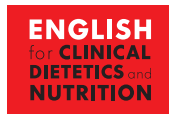Czarnym kolorem oznaczono: useful words and expresions, niebieskim kolorem oznaczono: useful words with prepositions, zielonym kolorem oznaczono: useful collocations.
BIA - bioelectrical impedance analysis
This is a fast, non-invasive and commonly used, commercialised method to estimate body composition. In the BIA test the alternating current flows through different compositions of the body. Tissues have different electrical properties and different resistance to the alternating current. Human body consists mostly of water with ions, through which the current can flow - placed in two compartments: extracellular water (ECW, about 45%) and intracellular water (ICW, about 55%). However, adipose tissues (a lower amount of water and electrolytes) are not as conductive as lean body tissues (a higher amount of water and electrolytes), and provide high resistance to the flow. The leaner the person, the less resistance to the current is observed.
BIA determines the electric impedance of an electric current passing harmlessly through the body of the patient. Impedance (Z) is the opposition to the flow of an alternating current, and consists of two components: resistance (R) and reactance (Xc). Resistance (R) is the major opposition of the conductor and measures total body water (TBW). Reactance is an additional opposition and measures Body Cell Mass (BCM).
Część artykułu pochodzi z piątego modułu (Body composition + estimating energy expenditure) kursu e-learningowego "English for Clinical Dietetics and Nutrition".






